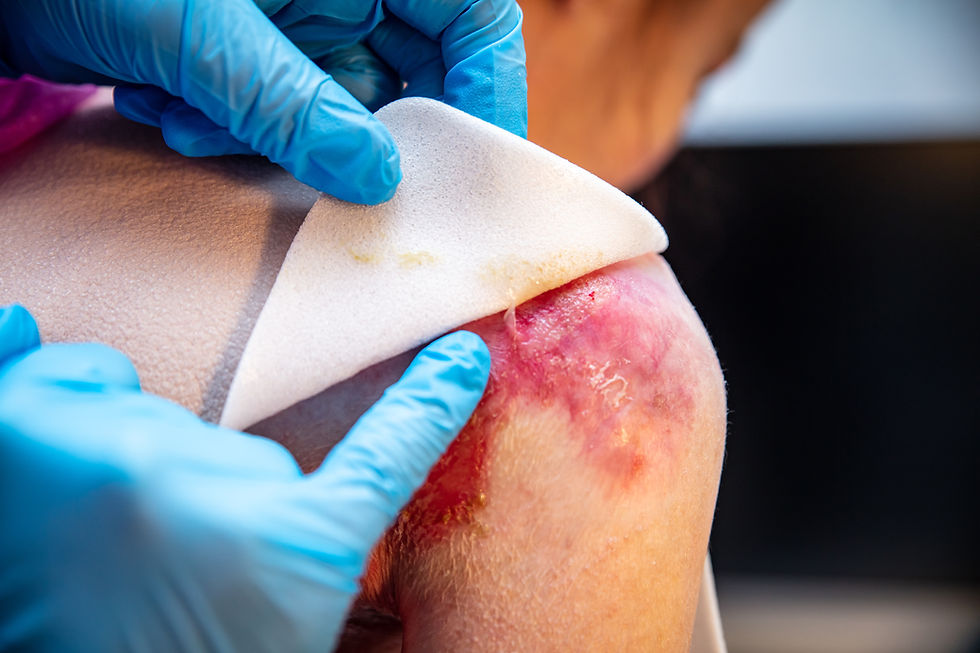National Burn Awareness Week: Understanding Burn Wound Recovery
- Mobile Wound Care MD
- Feb 4
- 3 min read
Each year, during the first full week of February, we observe National Burn Awareness Week—a time to educate the public about burn prevention and safety. Burns can be one of the most painful and challenging types of wounds to recover from. Whether caused by fire, scalding liquids, chemicals, or electrical sources, burns often require special care to avoid complications and ensure a smooth recovery process.
Burn wounds, depending on their severity, can impact both the body’s physical health and emotional well-being. Understanding how to properly care for burns and recognizing the importance of professional wound care is essential for anyone managing burn injuries.

How Burns Impact the Body and Wound Recovery
Burns are classified into three main categories based on their depth and severity:
First-degree burns: Affect only the outer layer of the skin (epidermis), causing redness and pain.
Second-degree burns: Affect both the epidermis and the second layer of skin (dermis), resulting in blistering and swelling.
Third-degree burns: Penetrate all layers of the skin and possibly even deeper tissues, often causing a leathery appearance and numbness due to nerve damage.
For any burn injury, the recovery process can be impacted by several factors, including the burn's severity, the location of the injury, and the patient’s overall health. Proper care is crucial to help wounds recover effectively and to prevent complications like infections or long-term scarring.
Key Steps in Burn Wound Care and Recovery
The recovery process for burn wounds can be lengthy, and following these guidelines can make a significant difference in the outcome:
Immediate Care: For minor burns, cool the burn area with running cold water for at least 10 minutes to reduce pain and swelling. Avoid using ice, as this can cause further tissue damage. For severe burns, seek medical attention immediately.
Protect the Wound: For second- and third-degree burns, always cover the wound with a sterile dressing to prevent infection. It’s important not to pop blisters as this can lead to further injury and infection.
Keep the Wound Clean: Follow your healthcare provider’s instructions on cleaning and dressing the wound to avoid introducing bacteria that could lead to infection.
Stay Hydrated and Nourished: Burns can dehydrate the body, so drinking plenty of water and eating a nutritious diet will support the recovery process and help the skin repair itself.
Monitor for Infections: Signs of infection include increased redness, swelling, or pus. If any of these occur, contact your healthcare provider immediately.
Pain Management: Burn wounds can be extremely painful. Over-the-counter pain relievers or prescribed medication can help manage discomfort, but always follow medical advice.
Emotional Support: Burns, especially severe ones, can cause emotional distress. Seeking emotional support or professional counseling can be a helpful part of the recovery process.
Preventing Burn Injuries
While National Burn Awareness Week focuses on recovery, prevention is just as important. By taking a few simple precautions, we can reduce the risk of burn injuries in our homes, workplaces, and communities:
Keep hot liquids, cooking equipment, and chemicals out of reach of children.
Install smoke alarms and fire extinguishers in your home.
Use oven mitts or tongs when handling hot items.
Always check the water temperature before bathing children.
Practice fire safety when cooking, especially near open flames.
Expert Care for Burn Wounds at Mobile Wound Care MD
Recovering from a burn injury requires expert attention, and Mobile Wound Care MD is here to help. Our specialized wound care team provides comprehensive treatment for burn wounds, helping to prevent complications and promote effective recovery.
If you or a loved one is dealing with a burn wound, don’t wait. Contact Mobile Wound Care MD today to learn more about our Mobile Wound Care services and how we can support your recovery.


Comments